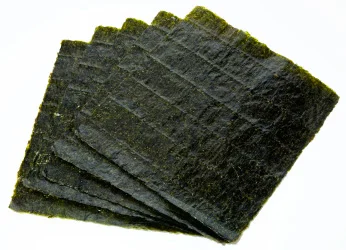What is nori?
Nori, the Japanese name for dry edible seaweed sheets is made from red algae (though it looks green). The red algae species used to make Nori are porphyra yezoensis and porphyra tenera.
It is gotten from the sea, washed with fresh water and then passed through a shredding machine that reduces it to small pieces. These pieces are mixed with freshwater, passed through square or rectangular frames, drained and then dried on a heated surface. The final results are dried seaweed sheets that are immediately packed and sealed to prevent moisture from getting in. The Nori making process is just like that of paper-making
There are different types of Nori
1. Light green Nori: this type of Nori is loosely woven and almost transparent. It can also be brown in colour. It is a cheap variety that is common because of its affordability. Its use for sushi is however limited because of its low quality.
2. The dark green Nori: this type of Nori, known as the sushi Nori is dark in colour to the point of almost being black. It is tightly woven, opaque and referred to as the “delicate shin-Nori”, meaning that it’s the Nori of the first of the year’s many harvests. It is preferred for making sushi: the darker it is, the better it is for sushi. In fact, you can make any sushi out of this.
Not any type of Nori can be used for sushi as it is the first ingredient the tongue comes into contact with. The best type of Nori the higher quality harvested earlier in the season. Its unique taste and high quality is a function of location, water temperature and mineral content of the sea. This might explain why the finest Nori can is produced on the Ariake Bay, Kyushu Island of Southern Japan.
The best type of Nori for sushi is that which is very dark in colour (like black) and uniformly thick. Upon closer inspection, it should be smooth, crisp, have a natural sweetness and subtle but rich flavour.
High quality Nori is also crunchy yet it melts easily in the mouth
If the Nori is brownish or obviously green in colour with a rough finish or irregularities, it’s of poor quality and should not be used for sushi. It is also tasteless and bland with a noticeable toughness that is not appealing.
How to use nori?
Nori is used in most kinds of sushi. It provides the roll with a unique seaweed flavor, holds many nutritious benefits and most importantly it plays a functional part by keeping the roll together.
A fresh nori should come dry, very dry. Once it interacts with the moist rice, it becomes sticky, hence when wrapping the rice it acts as a firm yet sticky “skin” for the sushi roll. For that reason, in order to make the most of the nori, it must be kept in a super-dry environment before used, or else, it will not stick well and the sushi roll will probably fall apart faster than you can say “Hara-kiri”.
Where can I get nori?
In most asian stores and markets probably. There are many producers and suppliers at different costs and values. You should find out which types suits your taste and budget best. It is important to know that nori sheets are hard to store after opening, and usually the remains are thrown away. Therefor it is best to buy the smaller packs of 10 sheets, rather than the larger 50 or 100 sheets packs.



Sushi Nori’s origin from South Korea, I saw many cheap price of Nori on Ebay market. Do you know that?
This nori stuff reminds of me of my internship in China. I was made to eat some sushi prepared with nori. Taste really great.
i was wondering what made up of Nori.
Thakns, I was wondering what that was 😛
Hey Jerry – Thanks for pointing out the grammer issue!
This is now fixed.